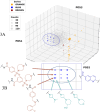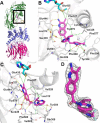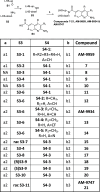From DNA-Encoded Library Screening to AM-9747: An MTA-Cooperative PRMT5 Inhibitor with Potent Oral In Vivo Efficacy
- PMID: 40102181
- PMCID: PMC11956014
- DOI: 10.1021/acs.jmedchem.4c03101
From DNA-Encoded Library Screening to AM-9747: An MTA-Cooperative PRMT5 Inhibitor with Potent Oral In Vivo Efficacy
Abstract
Inhibition of the methyltransferase enzyme PRMT5 by MTA accumulation is a vulnerability of MTAP-deleted cancers. Herein, we report the discovery and optimization of a quinolin-2-amine DEL hit that cooperatively binds PRMT5:MEP50 and MTA to generate a catalytically inhibited ternary complex. X-ray crystallography confirms quinolin-2-amine binding of PRMT5 glutamate-444, while simultaneously exhibiting a hydrophobic interaction with MTA. Lead optimization produced AM-9747, which selectively inhibits PRMT5-directed symmetric dimethylation of arginine residues of proteins, leading to a potent reduction of cell viability in MTAP-del cells compared to MTAP-WT cells. Once-daily oral dosing of AM-9747 in mouse xenografts is well tolerated, displaying a robust and dose-dependent inhibition of symmetric dimethylation of arginine in MTAP-del tumor-xenografts and significant concomitant tumor growth inhibition without any significant effect on MTAP-WT tumor xenografts.
Conflict of interest statement
The authors declare the following competing financial interest(s): All authors were employed with Amgen Inc when the research was conducted.
Figures

















Similar articles
-
MTA-cooperative PRMT5 inhibitors from cofactor-directed DNA-encoded library screens.Proc Natl Acad Sci U S A. 2025 May 20;122(20):e2425052122. doi: 10.1073/pnas.2425052122. Epub 2025 May 16. Proc Natl Acad Sci U S A. 2025. PMID: 40377999 Free PMC article.
-
Discovery of AMG 193, an MTA-Cooperative PRMT5 Inhibitor for the Treatment of MTAP-Deleted Cancers.J Med Chem. 2025 Apr 10;68(7):6932-6954. doi: 10.1021/acs.jmedchem.4c03121. Epub 2025 Mar 27. J Med Chem. 2025. PMID: 40146197 Clinical Trial.
-
Discovery of TNG908: A Selective, Brain Penetrant, MTA-Cooperative PRMT5 Inhibitor That Is Synthetically Lethal with MTAP-Deleted Cancers.J Med Chem. 2024 Apr 25;67(8):6064-6080. doi: 10.1021/acs.jmedchem.4c00133. Epub 2024 Apr 10. J Med Chem. 2024. PMID: 38595098 Free PMC article.
-
Protein Arginine Methyltransferase 5 (PRMT5) as an Anticancer Target and Its Inhibitor Discovery.J Med Chem. 2018 Nov 8;61(21):9429-9441. doi: 10.1021/acs.jmedchem.8b00598. Epub 2018 Jun 20. J Med Chem. 2018. PMID: 29870258 Review.
-
Targeting protein arginine methyltransferase 5 in disease.Future Med Chem. 2017 Nov;9(17):2081-2098. doi: 10.4155/fmc-2017-0089. Epub 2017 Oct 27. Future Med Chem. 2017. PMID: 29076773 Review.
Cited by
-
MTA-cooperative PRMT5 inhibitors from cofactor-directed DNA-encoded library screens.Proc Natl Acad Sci U S A. 2025 May 20;122(20):e2425052122. doi: 10.1073/pnas.2425052122. Epub 2025 May 16. Proc Natl Acad Sci U S A. 2025. PMID: 40377999 Free PMC article.
References
MeSH terms
Substances
LinkOut - more resources
Full Text Sources

